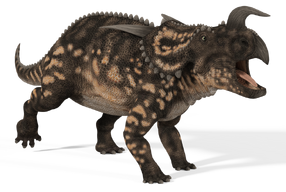Brandonjcruz (talk | contribs) (Adding categories) |
Brandonjcruz (talk | contribs) (Adding categories) |
||
| Line 11: | Line 11: | ||
[[Category:Dinosaurs]] |
[[Category:Dinosaurs]] |
||
[[Category:Dinosaurs of North America]] |
[[Category:Dinosaurs of North America]] |
||
| + | [[Category:Dinosaur Train Dinosaurs]] |
||
Revision as of 17:17, 18 October 2020

Einosaurus was a centrosaurid ceratopsian of the Upper Cretaceous period.Many Einiosaurus remains have been found together,stating that like the Pachyrhinosaurus and Centrosaurus,which lived at the same time,that it must have travelled in herds.It,s name means Buffalo Lizard.It lived in northwestern Montana,USA.
Einiosaurus was a herbivorous dinosaur and grew to 6 m (19.8 ft) in length. It is typically portrayed with a low, strongly forward-curving nasal horn that resembles a bottle opener, though this may only occur in some adults. Supraorbital (over-the-eye) horns are low and rounded if present at all, as opposed to ceratopsids with prominent supraorbital horns such as Triceratops. A pair of large spikes projects backwards from the relatively small frill. Einiosaurus lived in an inland habitat.
Einiosaurus is an exclusively Montanan dinosaur, and all its known remains are currently held at the Museum of the Rockies in Bozeman, Montana. At least 15 individuals of varying ages are represented by three adult skulls and hundreds of other bones from two low-diversity (in species) bonebeds, which were discovered by Jack Horner in 1985 and excavated from 1985-1989 by Museum of the Rockies field crews. These bonebeds were originally thought to contain a new species of Styracosaurus and are referred to as such in the comprehensive taphonomic study by Ray Rogers. In 1995 Scott D. Sampson formally described and named Einiosaurus procurvicornis from this material, as well as Achelousaurus horneri, also from a bonebed in this region.
The placement of Einiosaurus within Centrosaurinae is problematic due to the transitional nature of several of its skull characters, and its closest relatives are either Centrosaurus and Styracosaurus or Achelousaurus and Pachyrhinosaurus. The latter hypothesis is supported by Horner and colleagues, where Einiosaurus is the earliest of an evolutionary series in which the nasal horns gradually change to rough bosses, as in Achelousaurus and Pachyrhinosaurus which are the second and third in this series. The frills also grow in complexity.Regardless of which hypothesis is correct, Einiosaurus appears to occupy an intermediate position with respect to the evolution of the centrosaurines.